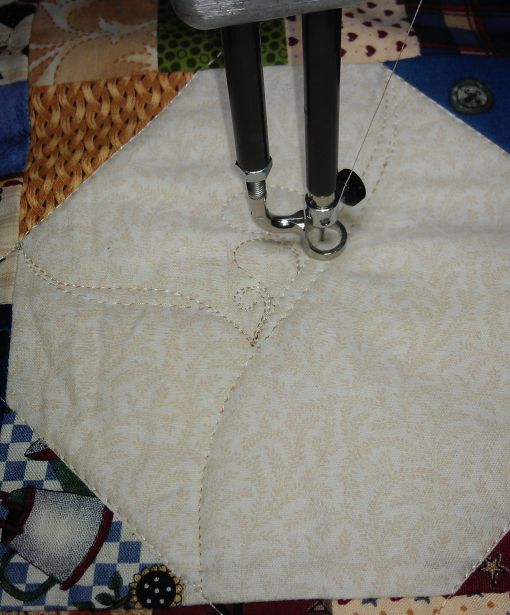When I was faced with the octagonal snowball blocks in one of the community quilts I quilted, I decided to stitch feathers. But making feathers flow nicely in an octagon is a challenge because of the odd angles. Here’s the end result, and how I did it.
(Note: I use a Handi Quilter Sweet Sixteen machine, but you can use this technique on any domestic sewing machine, mid- or long-arm quilting machine, or even hand stitching.)
The finished feathers inside an octagon:
Step 1
Stitch a long sweeping curve diagonally across the block from one corner to its diagonal opposite.
Step 2
Echo stitch back down that line to about the halfway point. This is the main spine.
Step 3
At about the halfway point, stitch out to another point on the octagon with a sweeping curve, then echo stitch back to the main spine. This creates one of the two minor spines.
Step 4
Where the spines join, stitch a little curl.
I can’t remember where I learnt this trick, but it’s a good one as it gives a curved shape ready for the feathers to curl around and avoids the issue of which side of the feather to start stitching, and thus which feather will dominate that space. And once the feather is finished, you really can’t notice that there’s a little curl in there unless you look hard for it. (Note this photo is taken from the side so I could get a clear photo of the curl.)
Step 5
Start stitching your feathers up one spine, using the curl to give your first feather its curve — it doesn’t matter which side of the space between the spines you start stitching. Don’t go too far over into the other half of the space, or leave too much space for the other side to fill — imagine about a halfway point and stitch your feathers to there.
When I’m stitching feathers, I think of commas — some people think of half hearts, but bulbous fleshy commas work for me 😉 I also leave a slight gap between my feathers and complete each one in its entirety — I don’t use the ‘bump’ method of stitching feathers, but that’s a personal preference, so use whatever method you like to stitch your feathers.
Step 6
After you’ve finished stitching the feathers along the first spine, stitch back down that spine to the curl, then start stitching the feathers on the other spine, again using the curl as your starting point. Try to make the feathers ‘kiss’ (or ‘air kiss’) the feathers on the other side of the space. When you’re finished, travel stitch back down the spine to the central area.
In the photo below, see how the curl looks like a feather once it’s surrounded by other feathers? And see how I have a small gap between the feathers and how each gap is a little different? And notice that some feathers just touch (kiss) the ones on the other side, and some don’t? You don’t have to be perfect! You’re looking for an overall effect, not a perfect feather every single time. Life’s too short…
Step 7
Your first inside space is now complete. That wasn’t so hard, was it? Now it’s time for the next space.
As before, from about halfway down the main spine, sweep out and echo stitch back in to create the second minor spine. You can add some interest by NOT starting the next minor spine from the same place as the first one.
The reason I create three spines (one major, two minor) is to break up the space, and because using an odd number is more pleasing to the eye than an even number (e.g. most [all?] flowers have an odd number of petals — 3, 5, 7, 9, etc. so if it works in nature, it has to work in quilting, right?).
Step 8
As before, stitch a curl at the junction of the spines, then stitch the feathers up one spine, then travel back down the spine, and stitch the feathers up the other side of the space, kissing (or air kissing) the feathers on the other side.
Step 9
Stitch back down to the beginning of the main spine (where you first started), echoing the first line of stitching.
Start stitching the next lot of feathers from the base, working your way up the spine and curving around the outside of one of the minor spines. Your aim is to fill the entire space.
When I’m stitching these feathers, there’s a temptation to create big feathers to fill the space. But these can look odd. So I just try to keep creating similar sized feathers to the previous ones. How? By adding *little* feathers in between the normal size ones, and by curving over those little feathers to kiss the *side* of another feather, not its ‘nose’, as shown in the second photo below.
Step 10
When you’ve finished filling the space, travel stitch back down the spines to the starting point and stitch feathers up the empty main spine and curve around to finish the feathers on the other minor spine, just like you did in Step 9.
Finished!
And you’re done! One octagonal shape filled with feathers:
Other hints
- I tried to stitch my feathers in all the octagon blocks of the quilt from every angle. I stitched the spines from top to bottom or bottom to top, other times from left to right or right to left, yet others on an angle. I did this to get practice at creating feathers from any position, no matter how the quilt is oriented to my machine or my body. While I can do that successfully now (LOTS of practice), I’m still not as good at stitching feathers ‘backwards’ from the top of the spine to the bottom — I still have to get to the bottom of the spine to start my next lot of feathers. One day….
- When you get to the top of the spine, you may have a space to fill. Just do a loop (like the top of a cotton swab tip) if you can’t do a curved feather in that space. Take a look at some of the photos above to see how I dealt with that odd space.
Have fun!

















[…] that showed the feathers off and that didn’t create massively large and odd-shaped feathers. I’ve written a tutorial (with pictures) on how I feathered these octagonal shapes — it’s really quite easy once you get the basic structure of the spines […]
This is the best tutorial for stitching feathers I’ve ever seen (and I’ve seen a LOT)!! I’ve finally given myself permission to do feathers and feel comfortable about them. Thank you so much, Rhonda, for sharing your method with us.
Very nice! Thank you for your generosity in time and knowledge for sharing!
Rhonda this will be very helpful when I get the chance (after the holidays) to give this a try. Your stitching is beautiful. I just recently got a babylock tiara. Sister to your sweet 16. Do you use the regulator when your doing your quilting?
Hi Mary
No, I don’t use the stitch regulator (Tru Stitch). It came out about a year or so after I got my machine, and I already had quite a bit of experience FMQ’ing. The quilts I quilt don’t get entered into competitions, so ‘perfect’ stitches aren’t a goal of mine. That said, you do get better with time and lots of practice 😉
–Rhonda